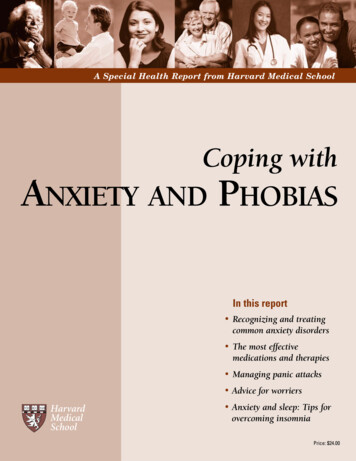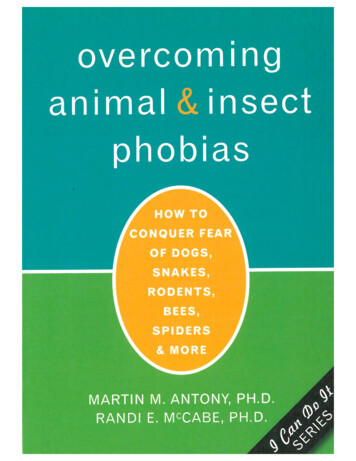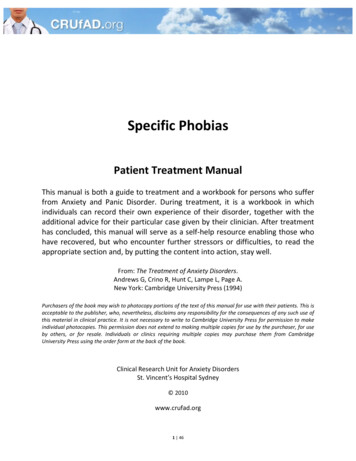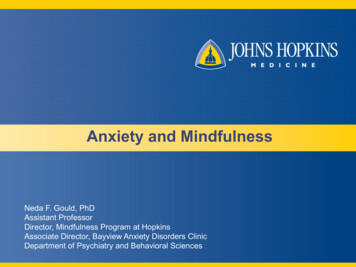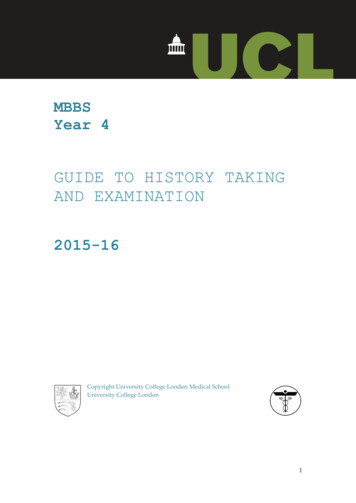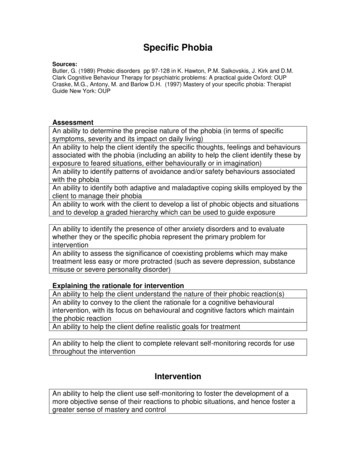
Transcription
Specific PhobiaSources:Butler, G. (1989) Phobic disorders pp 97-128 in K. Hawton, P.M. Salkovskis, J. Kirk and D.M.Clark Cognitive Behaviour Therapy for psychiatric problems: A practical guide Oxford: OUPCraske, M.G., Antony, M. and Barlow D.H. (1997) Mastery of your specific phobia: TherapistGuide New York: OUPAssessmentAn ability to determine the precise nature of the phobia (in terms of specificsymptoms, severity and its impact on daily living)An ability to help the client identify the specific thoughts, feelings and behavioursassociated with the phobia (including an ability to help the client identify these byexposure to feared situations, either behaviourally or in imagination)An ability to identify patterns of avoidance and/or safety behaviours associatedwith the phobiaAn ability to identify both adaptive and maladaptive coping skills employed by theclient to manage their phobiaAn ability to work with the client to develop a list of phobic objects and situationsand to develop a graded hierarchy which can be used to guide exposureAn ability to identify the presence of other anxiety disorders and to evaluatewhether they or the specific phobia represent the primary problem forinterventionAn ability to assess the significance of coexisting problems which may maketreatment less easy or more protracted (such as severe depression, substancemisuse or severe personality disorder)Explaining the rationale for interventionAn ability to help the client understand the nature of their phobic reaction(s)An ability to convey to the client the rationale for a cognitive behaviouralintervention, with its focus on behavioural and cognitive factors which maintainthe phobic reactionAn ability to help the client define realistic goals for treatmentAn ability to help the client to complete relevant self-monitoring records for usethroughout the interventionInterventionAn ability to help the client use self-monitoring to foster the development of amore objective sense of their reactions to phobic situations, and hence foster agreater sense of mastery and control
Cognitive restructuringAn ability to help the client understand the role of cognitions in maintainingphobias (e.g. misperception of risk associated with phobic situations, ormisinterpretation of interoceptive cues related to overbreathing)An ability to help the client understanding how fear of their physical reactions tophobic situations may contribute to maintenance (‘fear of fear’)An ability to help the client identify thoughts and assumptions which areassociated with anxiety, and to use guided discovery to generate alternativecognitionsAn ability to help the client generate behavioural experiments (usually as part ofthe exposure component) to test the validity of cognitions and assumptionsExposure componentAn ability to convey the rationale for exposure – both to explain the behaviouralmodel of phobic anxiety (using examples to explain how avoidance can maintainsymptoms), and to convey the sense that exposure is an opportunity to test thevalidity of relevant cognitions and assumptionsAn ability to work with the client to draw up a graduated list (or lists) of practiceand homework tasksAn ability to work with the client to ensure that exposure is graduated, repeatedand prolonged, and to identify any problems in the application of exposureAn ability to implement imaginal exposure where practical problems make it hardto implement in-vivo exposureAn ability to implement interoceptive exposure for clients who are fearful of bodilysensations in the phobic situationAn ability to help the client identify and circumvent any covert avoidance or theuse of safety behavioursAn ability to help clients with blood and injury phobia learn applied tensiontechniquesAn ability to help the client identify pertinent homework tasks (usually in-vivoexposure), to review progress and to plan further homeworkAn ability to make use of role playing and rehearsalAn ability to model non-phobic behaviour (e.g. approaching the phobic object)Maintenance of gainsAn ability to discuss strategies for the maintenance of gains and for managingsetbacks and relapse
Social PhobiaHeimberg/ Hope modelSources:Hope, D.A , Heimberg, R.G, & Turk, Cynthia, L. (2006) Managing social anxiety: A cognitivebehavioural approach. Oxford: OUPHeimberg R.G. and Becker, R.E. (2002) Cognitive-behavioral group therapy for social phobia.New York: Guilford PressKnowledge of the CBT model being appliedKnowledge of the CBT model being employed, which indicates that in socialsituations in which socially anxious individuals perceive the potential for negativeevaluation:they will form a mental representation of themselves based on priorexperience, current internal cues and cues based on their perceptions of thereactions of othersthey will continuously contrast this representation with their appraisal of the‘standard’ they perceive their “audience” to expectthey will preferentially allocate attention to monitor for evidence of anynegative feedbackthey will predict a high likelihood of negative evaluation and react to anydetected evidence of this with cognitive, behavioural and physiologicalsymptoms of anxiety, which in turn will feed back into their mentalrepresentation in subsequent social situationsEngagement and assessmentEstablishing a working relationshipA capacity to recognise the problems associated with social anxiety that couldadversely influence or inhibit the development of a therapeutic relationshipA capacity to adapt therapeutic style to manage client’s interpersonal difficultiesand excessive self-consciousness (e.g. using strategies such as reducing eyegaze, modulating social distance etc)Assessment of social anxietyAn ability to conduct a thorough assessment of the client’s difficulties, combininginformation from interview and relevant instruments in order to confirm adiagnosis of social anxietyAn ability to clarify the primacy of social phobia to other co-existing problems orpsychological disorders, and to determine appropriate intervention plans inrelation to comorbidity.An ability to use measures to aid evaluation of the full clinical picture and to gaina pre-treatment baselineAwareness of the potential impact of shame and anxiety on information given inthe initial assessment, and an ability to supplement information from the interviewwith measures
An ability to devise and carry out a pre-treatment behaviour test as part of theassessmentInterventionGeneral considerationsAn ability to be comfortable with, and to manage, manifestations of high levels ofanxiety (including anger in response to perceived threat)An ability to identify when clients are struggling with aspects of the intervention,to address the problem and if appropriate to adapt the intervention appropriatelyto meet the client’s needsAn ability to integrate the main elements of the intervention (exposure andcognitive restructuring), and to implement treatment in a manner which isstructured but responsive to the needs of the individual clientPsychoeducationAn ability to help the client conceptualise their own social anxiety in the context ofthe CBT model (the primacy of cognition, negative consequences of avoidanceand habituation)An ability to provide an overview of the treatment model, particularly its emphasison the active role of the client in applying their coping skills through homeworktasksAn ability to help the client conceptualise their difficulties in the context of thetreatment model, but also to acknowledge ways in which the client’s perspectivediffers from this modelAn ability to present a biopsychosocial model of aetiology which acknowledgesthe role of genetics and early experience, but which emphasises the role ofinformation processing biases in generating social anxiety and avoidanceAn ability to link the model to the major components of treatment (exposure,cognitive restructuring and homework tasks)An ability to assess the client’s perception of the credibility of therapy, and todiscuss these if there is an indication that the clients’ perceptions are likely toimpact on engagement (e.g. if the therapy is viewed sceptically or overenthusiastically)Establishing a hierarchy of feared situationsAn ability to help the client construct a hierarchy of feared and avoided socialsituations by working with the client to:“brainstorm” a list of feared and avoided social situations in order to ensurethat all potentially relevant situations are includedidentify a shortlist of approximately 10 situations that are representative ofthe client’s current difficulties, and which range from mildly to more severely
anxiety provokingrank order the situationsidentify the dimensions that make the situations easier or harder to manage(e.g. characteristics of other persons present, or the nature of the situation)rate the degree of fear and avoidance for each situation using SUDS(Subjective Units of Discomfort Scale)Self-monitoringAn ability to help clients begin self-monitoring of their social anxiety and mood,using in-session practice to check that the client understands the procedure, thatthey understand the rationale for monitoring, and to identify and ‘troubleshoot’any potential barriers to monitoringAn ability consistently to review the self-monitoring across and within all sessionsWhere the client has difficulty in self-monitoring, an ability to help them identifyand resolve any issues which make self-monitoring problematicCognitive RestructuringAn ability to explain the concept of automatic thoughts and to offer appropriateillustrative examples, with the aim of helping the client identify that it is not theevent itself which creates anxiety, but their interpretation of that eventAn ability to discuss the concept of cognitive restructuring with the client, with theaim of helping the client to understand this as an opportunity to appraise thevalidity of their thoughts, rather than to see these thoughts as ‘wrong’An ability to help clients identify and self-monitor automatic thoughts, and tomake links between these and the emotions, behavioural and physiologicalreactions they give rise toAn ability to help clients who find it difficult to access automatic thoughts, usingstrategies such as review of specific situations, or helping them to translate ofimages of situations into verbal statementsAn ability to help clients challenge automatic thoughts by:explaining the concept of information processing biases and offeringillustrative exampleshelping the client to consider these biases in relation to their own automaticthoughtsmaking systematic use of “Disputing Questions (e.g. what evidence do Ihave that , do I know for certain that etc) to appraise the validity of theirautomatic thoughtsgenerating phrases or statements that summarise the most important pointsmade when challenging specific automatic thoughts (‘rational responses’)
ExposureAn ability to conduct an initial in-session exposure by working with the client to:choose an appropriate situation, fixing an appropriate duration for theexposure and ensuring that the exposure is carried outidentify and agree achievable behaviour goals for the role playidentify automatic thoughts and using cognitive restructuringmake ratings of SUDS during and after the exposureAn ability to debrief after exposure, ensuring that the client’s perceptions arethoroughly exploredAn ability to provide feedback on the exposure task in a constructive mannerwhich is both accurate and honest, and which focuses on contrasting the client’sactual performance with their prior beliefsAn ability to help the client summarise what they have learnt from the exposurethat can be applied to future situationsAn ability to plan appropriate in-session exposuresAn ability (where appropriate) to make use of external role players (which willinvolve briefing the client and giving guidance to role-players regarding theirfeedback to the client)With clients who refuse or avoid exposure, an ability to explore their concernsand to develop a plan for proceeding which accommodates theseWhere clients react catastrophically to a completed exposure exercise, an abilityto help them appraise their perceptions of the experienceAn ability to agree and to assign self-exposure homework which explicitlyincludes the three elements of exposure, self- monitoring and cognitiverestructuringAn ability to work with the client to design effective exposure tasks for specificmanifestations of social anxiety (e.g. signing name in public, eating or drinking inpublic, fear of using public toilets), incorporating the feared outcome where a lossof control or fear of humiliation is a significant part of the anxietyAn ability to help the client focus on automatic thoughts prior to exposure in agraduated manner (usually starting with situationally-based performance-relatedthoughts, at later stages considering thoughts related to negative self-evaluation)An ability to review homework tasks, and to explore and resolve any difficultiesthe client has in completing these tasksAddressing core beliefsAn ability, usually at later stages of therapy, to identify core beliefs and to discusswith the client the ways in which these beliefs may generate and/or maintain theirsocial anxietyAn ability to help the client ‘unpack’ the meaning of emotionally loaded words(such as ‘perfect’ ‘right’ ‘best’) in order to identify core beliefsAn ability to challenge core beliefs using cognitive restructuring and exposure
Ending therapy and planning for relapse preventionAn ability to assess overall progress, and to make decisions about furthertreatment based on measures and client self-monitoring formsAn ability explicitly to discuss the issue of relapse, and to help clients considerhow they can employ the skills they have learned after treatment endsAn ability to acknowledge client’s feelings about losing therapist contact
Social phobiaClark and Wells modelSources:Clark, D.M. (2005) A cognitive Perspective on Social Phobia in W. Ray Crozicr W.R.& L.L.Alden.The Essential Handbook of Social Anxiety for Clinicians Chichester: John Wiley & Sons.Wells, A. (1997). Cognitive therapy of anxiety disorders: A practice manual and conceptual guide.Chichester, United Kingdom: Wiley.Clark D.M. (in press) Cognitive therapy for social phobiaGeneric competenciesAssessmentAn ability to gain an overview of the development and course of the problemand any prior treatmentProblem specific competenciesKnowledgeKnowledge of the cognitive model of social phobia, including a clearunderstanding of the maintaining factors specified in the model (self-focusedattention, processing of the self as a social object and safety behaviours).Establishing a working relationshipA capacity to recognise the problems associated with social phobia that couldadversely influence or inhibit the development of a therapeutic relationshipA capacity to adapt therapeutic style to manage client’s interpersonaldifficulties and excessive self-consciousness (e.g. using strategies such asreducing eye gaze, modulating social distance etc)AssessmentAn ability to clarify the primacy of social phobia to other co-existing problemsor psychological disorders, and to determine appropriate intervention plans inrelation to comorbidity.An ability to identify details of the client’s current social networkAn ability to identify current psychotropic medication and recreational druguse and its impact on the social phobiaAn ability to administer and review standardised questionnaires relating tosocial anxietyAn ability to integrate information from these questionnaires into theassessment interview, where appropriate using responses to guidequestioningAn ability to gain detailed information about the social situations in whichanxiety is manifested, or which are avoided because of fearAn ability to identify patients’ specific negative automatic thoughts and fearfulpredictions about social interactions
An ability to identify the anxiety symptoms triggered by negative automaticthoughtsAn ability to identify the specific ways in which increase self-focussedattention and self-monitoring are manifested in anxiety-provoking situationsAn ability to elicit the images or impressions that form client’s self-image insocial situations (i.e. how they think they appear to others)An ability to identify socially traumatic early experiences associated with theinitial development of the client’s negative self-image/impression.An ability to identify the safety behaviours that arise in the context of negativeautomatic thoughtsAn ability to identify the anticipatory negative thoughts and images which theclient experiences prior to a social situationAn ability to identify ‘post-mortem’ negative thoughts and images which theclient uses to review/appraise social experiencesAn ability to identify any problematic social beliefs held by clients (such asexcessively high standards, conditional beliefs and unconditional beliefs)An ability to assess beliefs about what can be changedCase formulationAn ability to construct an individualised cognitive model of social phobia(which links the main negative automatic thoughts, safety behaviours, anxietysymptoms and the contents of self-focussed attention (self-consciousness)An ability to use an individualised cognitive model of social phobia to guidetreatment, working with the client to build the model collaborativelyInterventionSocialisation to the modelAn ability to help the client understand the relevance of the cognitive model ofsocial phobia to their difficulties using guided discovery rather than a didacticapproachAn ability to clarify and agree with the client specific and realistic goals for theinterventionManipulation of self-focused attention and safety behavioursAn ability to set up an experiential exercise in which clients vary their selffocused attention and safety behaviours (by role-playing a feared interaction,in one condition focusing attention on themselves and employing safetybehaviours, in the other dropping safety behaviours and focusing on the otherperson)An ability to use the experiential exercise to help clients become aware of theway in which self-focussed attention and safety behaviours increase (ratherthan decrease) their social anxiety (by increasing their negative views of theirperformance and interfering with the social interaction).
Helping clients to use feedbackAn ability to make use of feedback to help clients obtain realistic informationabout how they appear in social situations, using feedback based on video,audio and still photographs, and eliciting and skilfully using feedback fromother people in the interactionAn ability to help clients prepare for watching/listening to tapes by usingcognitive preparation (such as describing and operationalising how they thinkthey will appear prior to viewing tapes, and using this to contrast to actualbehaviour)When clients remain concerned about their social performance after reviewingtapes, an ability a) to engage in discussion of these concerns, and b) toidentify instances where engaging in safety behaviours produces thebehaviours which the client is concerned about.Attention trainingAn ability to explain the rationale for training clients in non-evaluative,externally-focussed attention.An ability to help clients develop the skill of being externally focussed in anon-evaluative manner in social situations, using a systematic programme ofexercises that develop this skill in non-social and social situations.An ability to set and review attention training homework.Behavioural experimentsAn ability to work with clients to develop behavioural experiments that can testtheir negative beliefs about how they appear to other people, as well as theirbeliefs about what will happen if they confront feared and avoided socialevents and tasks.An ability to work with clients to devise behavioural experiments across arange of contexts (in-office tasks, out of the office but therapist accompaniedtasks and homework tasks)An ability to devise behavioural experiments which can correct overestimatesof both the probability and the cost of feared outcomesAn ability to help patients to obtain the maximum amount of correctiveinformation during behavioural experiments by dropping their safetybehaviours and configuring their attention appropriatelyAn ability to structure behavioural experiments using a record sheet whichidentifies client’s predictions about the social event, the ‘experiment’ used totest this prediction, the actual outcome and the learning which ensues.Where clients have rigid rules about acceptable and unacceptable socialbehaviours an ability to construct behavioural experiments aimed at testingout the realism of these rules and increasing social flexibilityAn ability to conduct and use surveys of other people’s views to help clientschange their negative beliefs.An ability to use discussion and behavioural experiments (including positive
data logs) to challenge the client’s unconditional assumptions their social self(e.g. “I am unlikeable).Managing anticipatory and post-event processingAn ability to help clients identify the ways in which they think and behavebefore social eventsAn ability to help the client weigh the pros and particularly the cons ofanticipatory thoughts and behavioursAn ability to help the client to stop employing anticipatory thoughts andbehaviours using behavioural experiments to test their (lack of) utilityAn ability to help clients desist from using “post-mortem” analysisManaging assumptions and negative automatic thoughtsAn ability to help clients reappraise excessively high or rigid standards ofsocial behaviour using behavioural experiments designed to test the realismof these standardsFor clients who hold particularly strong negative self-beliefs, the ability to helpclients operationalise and appraise these beliefsFor clients who are prone to discount information which contradicts negativeself beliefs, an ability to facilitate client’s use of a positive data logAn ability to work collaboratively to challenge negative automatic thoughts byexamining their validity, reframing in more realistic terms and consideringstrategies for managing realistic appraisalsAn ability to help the client use discrete positive self statements (which theythemselves have generated) to counter negative automatic thoughts or ‘selfprocessing’Rescripting early memories linked to current, intrusive and negative selfimages.An ability to help client’s to identify links between memories of early sociallytraumatic events and their current negative, intrusive self-images in socialsituationsAn ability to identify an “encapsulated belief” that summarizes the meaning ofboth the early memory and the intrusive self-imageAn ability to use cognitive restructuring to help the client to reappraise theencapsulated belief and develop an alternative more realist perspectiveAn ability to incorporate the new perspective into the social trauma memorythrough a three stage imagery rescripting procedure, using changes in affectas the index of successMetacompetenciesAn ability to introduce and implement the components of the programme in amanner which is flexible and which is responsive to the issues the clientraises, but which also ensures that all relevant components are included
Panic Control Therapy (PCT)1Barlow modelSource:Craske M.G. and Barlow D.H. (2007) Mastery of your anxiety and panic (Therapist guide) 4thedition) Oxford: Oxford University PressProblem specific competenciesKnowledgeAn ability to make use of knowledge of the model underpinning PCT (whichassumes that panic arises from a vicious cycle arising from catastrophicmisattribution of bodily sensations mediated by interoceptive conditioning (alearned association between internal or external cues and unexpected panics)and maintained by avoidance behaviours).An ability to make use of knowledge of the DSM criteria for panic disorder, and oforganic conditions which may produce panic symptomsCapacity to undertake assessment and derive a case formulationAn ability to conduct an assessment that aims to identify and appraise presentingproblems in the domains of:behaviours (e.g. avoidance, or other coping behaviours)cognitions (e.g. perception of intensity of the symptoms and perceivedconsequences of symptoms)somatic reactions (e.g. increased heart rate etc)An ability to derive a detailed description of each clients idiosyncratic patterns ofbehavioural, cognitive and somatic reactions, and which also describes the socialcontext in which these patterns presentAn ability to establish that panic disorder is the primary presentation (i.e. toidentify panic that arises in the context of other anxiety disorders (such asspecific phobia or social phobia), and to exclude the possibility that other(particularly more serious problems) are more relevantA capacity to apply the basic treatment model in order to construct an individualcase formulationAn ability to make use of a ‘graduated funnel’ approach to obtain information(moving from global to more detailed questions)An ability to determine functional relationships between a) avoidance behaviours,cognitions and panic, and b) internal/ external cues and panic.1Earlier versions of PCT included progressive muscle relaxation as a component of theintervention. As current versions of PCT do not include this, relaxation is not described in thiscompetence list.
An ability to assess both the range and the degree of reliance on safety signalswhich contribute directly to the maintenance of panicAn ability to instruct clients in the use of structured recording (e.g. WeeklyRecord and the Panic Attack Record)Explaining the rationale for interventionAn ability to help the client understand their own experience of panic by givingthem information regarding the somatic features and psychological responseswhich contribute to its maintenance (the vicious cycle of panic and therelationship between physiological arousal, cognitions and behaviour)An ability to help clients understand the relevance of this model to themselvesand to the intervention.An ability to help clients understand the relevance of the three components of theintervention (breathing skills training, cognitive techniques and exposure therapy)and the rationale for their useInterventionAcross all components of the intervention, and ability to work with the client toagree and regularly to review homework assignments, and to encourage selfmonitoring using appropriate record formsCognitive treatment componentAn ability to help clients to learn to monitor their cognitions, with a view toidentifying the kinds of predictions, interpretations and self-statements they makein anxiety-provoking situations.An ability to help clients to explore alternative explanations for anxiety-provokingcognitionsAn ability to help clients to learn to treat their cognitions as hypotheses ratherthan facts, and to detect common information processing errors (such asovergeneralisation, all or nothing thinking etc)An ability to help clients learn techniques for decatastrophising cognitions,especially those relating to the anticipated consequences of feared eventsAn ability to help clients worrying over specific events to identify which aspects ofthe situation they have control over, and which they do not, with the aim ofreducing worry regarding events over which they have no controlAn ability to construct behavioural experiments which help clients learn how touse behavioural experiments to test-out their beliefs regarding anxietyAn ability to help clients learn to use coping self-statements to help them managefear and anxiety-provoking situationsAn ability to help clients generalise cognitive coping skills to a range of situations
Breathing skillsAn ability to help the client understand the physiological consequences ofoverbreathing and the way in which misconstrual of these effects can contributeto panicAn ability to help the client learn diaphragmatic breathing, with the primary aim ofhelping clients to employ this approach during exposure (helping them to breakthe panic cycle and hence engage with, and gain a sense of mastery in, anxietyprovoking situations)An ability to help the client learn diaphragmatic breathing both in a relaxingenvironment and to generalise this skill to more anxiety-provoking situationsExposure treatment componentAn ability to explain the rationale for exposure therapy, in particular its use as away of helping clients re-evaluate anticipated consequences and to learn totolerate (rather than rigidly to avoid) fear and anxiety cued by both situational andinteroceptive (somatic) stimuliAn ability to introduce the concept of hierarchical exposure and to help clients toconstruct a hierarchy of feared situations for both situational and interoceptiveitems, and their combinationAn ability to work with the client to implement exposure in a manner whichmaximises the probability of benefit, in terms of its structure (e.g. number ofsituations faced, duration and pacing), as well as helping the client identify andcircumvent any covert avoidance or the use of safety behavioursAn ability to identify, plan and implement interoceptive ,in vitro and in vivoexposure to help clients learn that some physiological sensations can by inducedbehaviourally and / or cognitivelyAn ability to identify when it would be helpful to involve significant others inexposure, and to plan and implement thisAn ability to help the client follow-up any therapist-directed exposure with selfdirected exposureAn ability to help the client review exposure experiencesAn ability to help clients draw upon skills learnt within the cognitive and relaxationcomponents of the intervention to help them to manage anxiety when undergoinggraded exposure tasksTermination and relapse preventionAn ability to work with the client to reduce likelihood of relapse (e.g. by helpingthem identify the procedures they have
Clark Cognitive Behaviour Therapy for psychiatric problems: A practical guide Oxford: OUP Craske, M.G., Antony, M. and Barlow D.H. (1997) Mastery of your specific phobia: Therapist Guide New York: OUP Assessment An ability to determine the precise nature of the phobia (in terms of specific symptoms,

